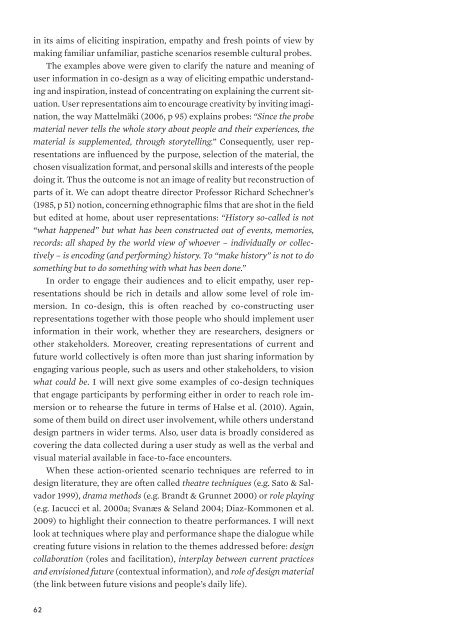Design games as a tool, a mindset and a structure Kirsikka Vaajakallio
Design games as a tool, a mindset and a structure Kirsikka Vaajakallio
Design games as a tool, a mindset and a structure Kirsikka Vaajakallio
You also want an ePaper? Increase the reach of your titles
YUMPU automatically turns print PDFs into web optimized ePapers that Google loves.
in its aims of eliciting inspiration, empathy <strong>and</strong> fresh points of view by<br />
making familiar unfamiliar, p<strong>as</strong>tiche scenarios resemble cultural probes.<br />
The examples above were given to clarify the nature <strong>and</strong> meaning of<br />
user information in co-design <strong>as</strong> a way of eliciting empathic underst<strong>and</strong>ing<br />
<strong>and</strong> inspiration, instead of concentrating on explaining the current situation.<br />
User representations aim to encourage creativity by inviting imagination,<br />
the way Mattelmäki (2006, p 95) explains probes: “Since the probe<br />
material never tells the whole story about people <strong>and</strong> their experiences, the<br />
material is supplemented, through storytelling.” Consequently, user representations<br />
are influenced by the purpose, selection of the material, the<br />
chosen visualization format, <strong>and</strong> personal skills <strong>and</strong> interests of the people<br />
doing it. Thus the outcome is not an image of reality but reconstruction of<br />
parts of it. We can adopt theatre director Professor Richard Schechner’s<br />
(1985, p 51) notion, concerning ethnographic films that are shot in the field<br />
but edited at home, about user representations: “History so-called is not<br />
“what happened” but what h<strong>as</strong> been constructed out of events, memories,<br />
records: all shaped by the world view of whoever – individually or collectively<br />
– is encoding (<strong>and</strong> performing) history. To “make history” is not to do<br />
something but to do something with what h<strong>as</strong> been done.”<br />
In order to engage their audiences <strong>and</strong> to elicit empathy, user representations<br />
should be rich in details <strong>and</strong> allow some level of role immersion.<br />
In co-design, this is often reached by co-constructing user<br />
representations together with those people who should implement user<br />
information in their work, whether they are researchers, designers or<br />
other stakeholders. Moreover, creating representations of current <strong>and</strong><br />
future world collectively is often more than just sharing information by<br />
engaging various people, such <strong>as</strong> users <strong>and</strong> other stakeholders, to vision<br />
what could be. I will next give some examples of co-design techniques<br />
that engage participants by performing either in order to reach role immersion<br />
or to rehearse the future in terms of Halse et al. (2010). Again,<br />
some of them build on direct user involvement, while others underst<strong>and</strong><br />
design partners in wider terms. Also, user data is broadly considered <strong>as</strong><br />
covering the data collected during a user study <strong>as</strong> well <strong>as</strong> the verbal <strong>and</strong><br />
visual material available in face-to-face encounters.<br />
When these action-oriented scenario techniques are referred to in<br />
design literature, they are often called theatre techniques (e.g. Sato & Salvador<br />
1999), drama methods (e.g. Br<strong>and</strong>t & Grunnet 2000) or role playing<br />
(e.g. Iacucci et al. 2000a; Svanæs & Sel<strong>and</strong> 2004; Diaz-Kommonen et al.<br />
2009) to highlight their connection to theatre performances. I will next<br />
look at techniques where play <strong>and</strong> performance shape the dialogue while<br />
creating future visions in relation to the themes addressed before: design<br />
collaboration (roles <strong>and</strong> facilitation), interplay between current practices<br />
<strong>and</strong> envisioned future (contextual information), <strong>and</strong> role of design material<br />
(the link between future visions <strong>and</strong> people’s daily life).<br />
62
















